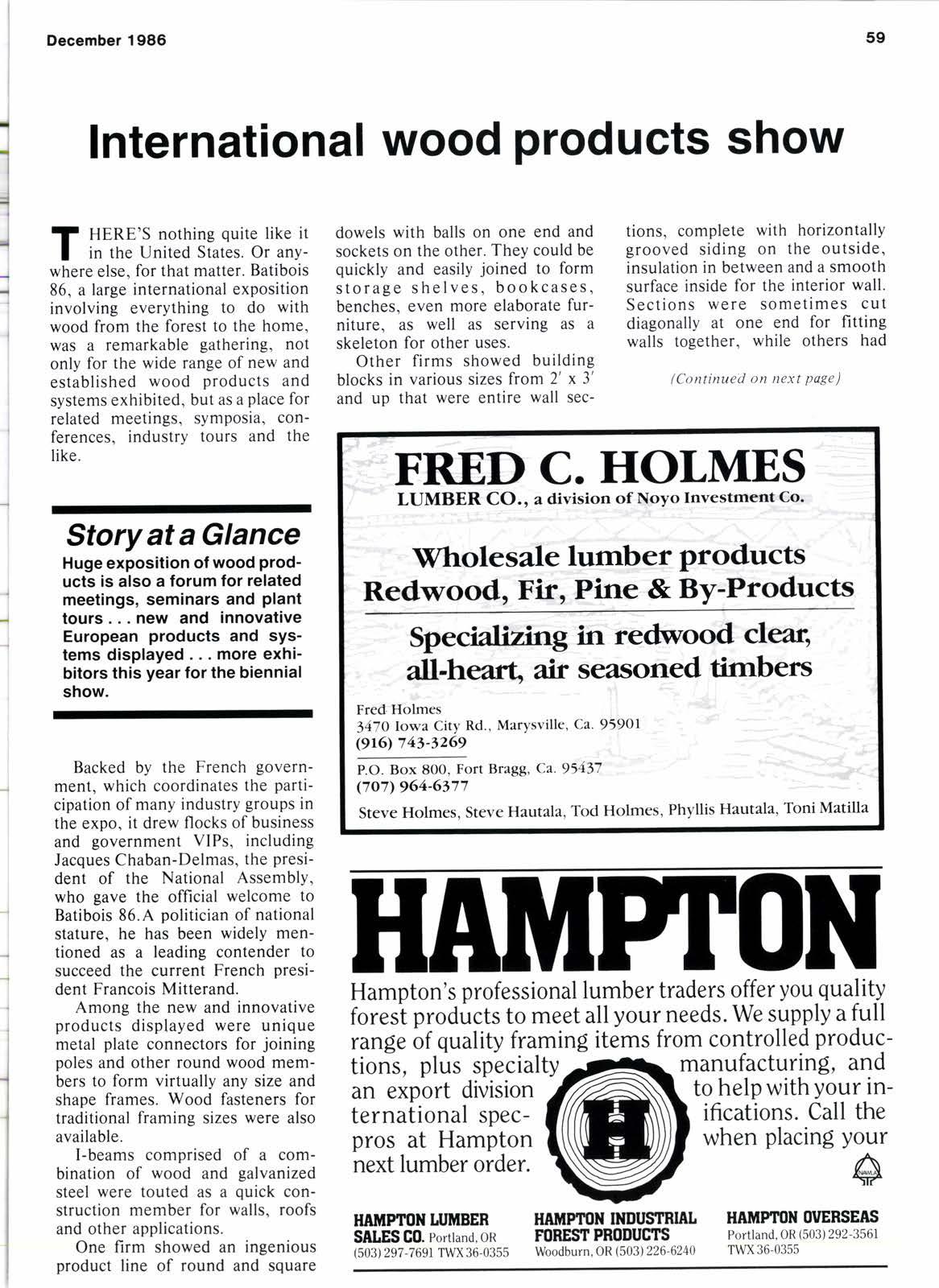
9 minute read
International wood products show
f HeRe'S nothing quite like it I in the United States. Or anywhere else, for that matter. Batibois 86, a large international exposition involving everything to do with wood from the forest to the home. was a remarkable gathering, not only for the wide range of new and established wood products and systems exhibited, but as a place for related meetings, symposia, conferences, industry tours and the like.
Story at a Glance
Huge exposition of wood products is also a forum for related meetings, seminars and plant tours. new and innovative European products and systems displayed .. more exhibitors this year for the biennial show.
Backed by the French government, which coordinates the participation of many industry groups in the expo, it drew flocks of business and government VIPs, including Jacques Chaban-Delmas, the president of the National Assembly, who gave the official welcome to Batibois 86.A politician of national stature, he has been widely mentioned as a leading contender to succeed the current French president Francois Mitterand.
Among the new and innovative products displayed were unique metal plate connectors for joining poles and other round wood members to form virtually any size and shape frames. Wood fasteners for traditional framing sizes were also available.
I-beams comprised of a combination of wood and galvanized steel were touted as a quick construction member for walls, roofs and other applications.
One firm showed an ingenious product line of round and square dowels with balls on one end and sockets on the other. They could be quickly and easily joined to form storage shelves, bookcases, benches, even more elaborate furniture, as well as serving as a skeleton for other uses.
Other firms showed building blocks in various sizes from 2' x 3' tions, complete with horizontallY grooved siding on the outside, insulation in between and a smooth surface inside for the interior wall. Sections were sometimes cut diagonally at one end for fitting walls together, while others had
/Continued on next page) and up that were entire wall sec-
Fred flirlmes 347O lowa City Rd., Marysville, Ca. 959O1 (916) 743-3269
P.O. Box 800, Fort Brryg, Ca.9)437 (7o7) 964-6377
Steve Holmes, Steve Hautala, Tod Holmes, Phyllis Hautala, Toni Matilla
Hampton's professional lumber traders offer you qualit-y foresi products to meet all your needs. We supply a full range of quality framing items from controlled produc:f 11,3it'oifffi'fi next lumber order.
W000 H0ilES are still a rarity in France. These four architects' homes in the Bordeaux area show a cautious approach to wood use. A shortage ol skilled craftsmen exists, yet interest in more wood construction is growing, aided by government and industry eflorts. lll Horizontal siding is often seen. l2l Built in 1981 this hbme shows limited application of exterior moulding. l3l Not all design approaches are successful, at least to the American eye. llf 1980 house, built in U-shape features flat roofs, vertical mansards and stucco walls. Cedar is a favored interior wood.
lnternational Products Show
(Continued from previous page) openings included for doors and windows.

As in the U.S., wood preserving is a growing market. Announced at Batibois (pronounced batty-bwah) were the four official classifications for treated wood by the Association
Francaise pour la Preservation du Bois or the French wood preservation association.
The AFPB allows four classes: one and two involve brushed or painted on chemical preservatives for non-ground contact applications, while classes three and four are for wood pressure treated with water borne chemicals for use as sill stock and other ground contact applications. The AFPB is a rules writing and control organization only, similar to such groups in this country.
The computer revolution and the French enthusiam for it were much in evidence. Virtually scores of new software applications have been developed for applications ranging from land planning use through construction to product design. Videotext, a computer method of bringing up information on practically any subject, was featured as well. Videotext has been a big success in France as the government has spent millions to force the development and use of this communication and information retrieval method. Experiments with it in the U.S. have not been commercially successful.
There were 291 exhibitors with 72 ofthem from l9 other countries, truly an international exposition. Like the attendance figures of more than 10,000 professional visitors, these numbers represent a slight increase from the first Batibois, held in 1984. The show will next be held October 4-9, 1988.
The expo was again in Bordeaux, France. While perhaps better known for its outstanding red wines, Bordeaux is also adjacent to the largest single pine forest in Europe. The city will also be the site for the 1988 version. In addition to a large local wood industry, the Port of Bordeaux is active in shipping wood products. The Star Shipping Co., for example, has regular container line runs to Long Beach and Oakland. Ca.
Despite the talk here of our increased effort to reduce our trade deficit, there was not a single American exhibitor at this year's show. While several well-known American companies and their products were displayed, the exhibitors were their European representatives. Only a handful of American visitors were to be seen, a lamentable fact as Batibois has much to offer anyone connected to the wood business. Some observers expect increased American participation as the show becomes better known.
Seven nations took official part in Batibois: Cameroon, Canada, Finland, Ghana, Hungary, Ivory Coast and Sweden. Their displays showed a high level of professionalism and commitment to vigorously marketing the woods of their respective countries.
The Swedes and Finns had a joint exhibit, part of a Scandinavian tradition of cooperating in such matters. Directly across the aisle was a large Canadian exhibit tied in with the Swedes and Finns.
The Canadians were promoting panels and siding in Western red cedar (or Cedre Rouge de L'Ouest in that market) as well as Douglas fir sheathing, plywood and even framing lumber. Interestingly, the French are now growing their own Doug fir, the outgrowth of reforestation efforts in war damaged areas in central France after the end of World War II.
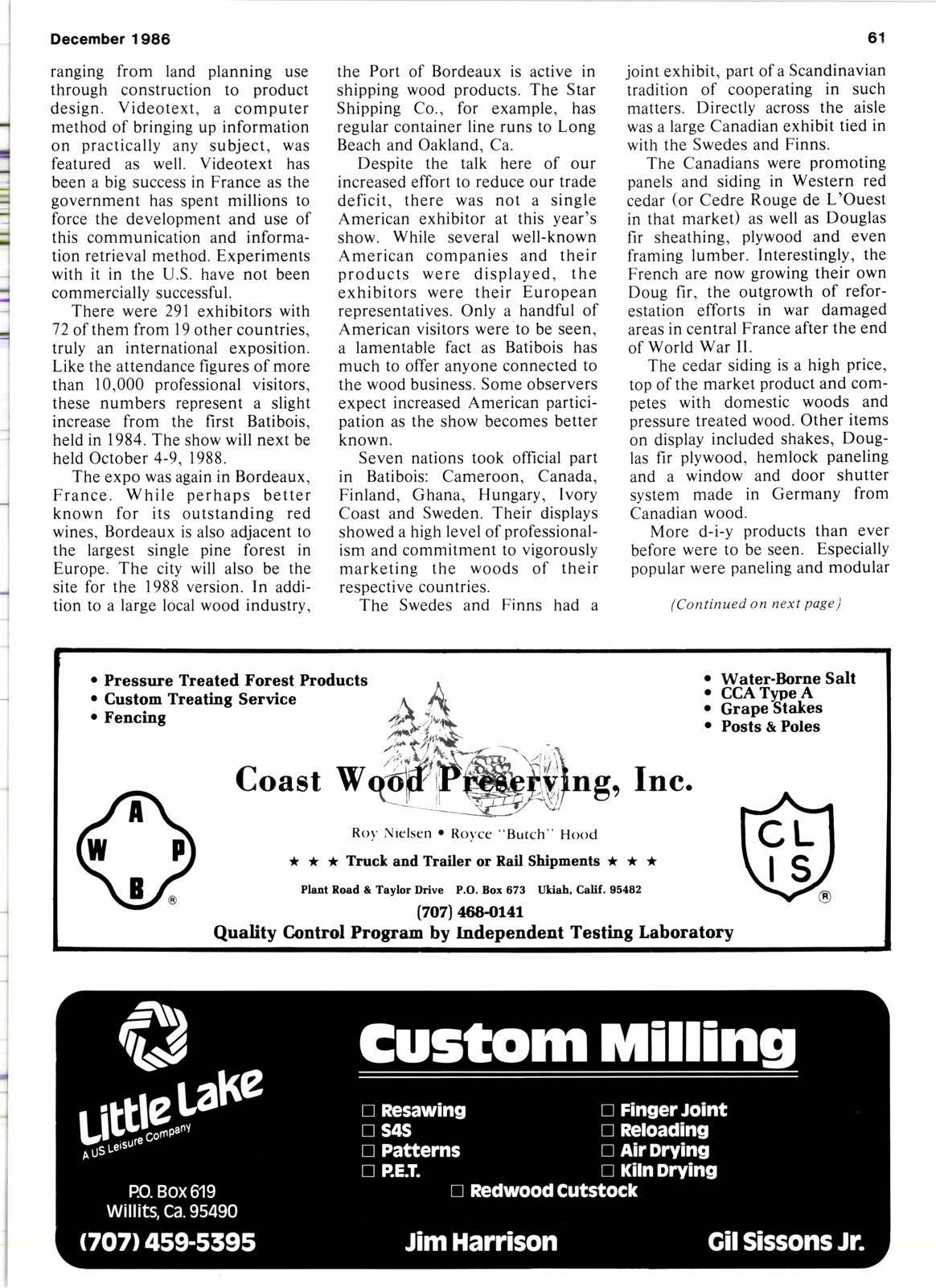
The cedar siding is a high price, top of the market product and competes with domestic woods and pressure treated wood. Other items on display included shakes, Douglas fir plywood, hemlock paneling and a window and door shutter system made in GermanY from Canadian wood.
More d-i-y products than ever before were to be seen. EsPeciallY popular were paneling and modular
(Continued on next Page )
lnternational Products Show
(Continued from previout page) components, i.e., spindles, dowels and panels for tables, tv stands, shelves, furniture and the like.
For example, Societe Industrielle Forestiere showed a handsome line of d-i-y paneling in their Decorland line. The pastel colored tongue and groove wood strips are approximately 4" x l', 2' and 3' in length and are painted, then varnished. The firm sells throughout Europe and is currently eying the American market as are a number of other European building product producers.
Various federations and trade associations held meetings in conjunction with the show. The Spanish Timber Confederation met as did several French organizations.
GLULAM (European Group of Manufacturers of Glulam frames) celebrated its 2Oth anniversary with a gathering. Several African countries took part in the Conference of African Ministers of Construction, also held at Batibois.
A wide variety of technical visits to sawmills, industrial plants, cabinet and furniture factories were also included. (see accompanying photos of a tour of architects' all wood homes.)
One of the other tours was a visit to Villabois, a I 17 home village of all wood houses built as part of the first Batibois in 1984. After two years the homes appear in good condition (Bordeaux has a relatively mild climate) but still show signs of their hasty erection. Batibois (a shorthand kind of word meaning, roughly, wood in construction) fulfilled its role of being an international gathering point for those interested in wood and wood construction. The displays and related activities left no doubt the show's future is brieht indeed.
Denny
(Continued front page 45) tional lumber, hardware and home improvement companies utilized.
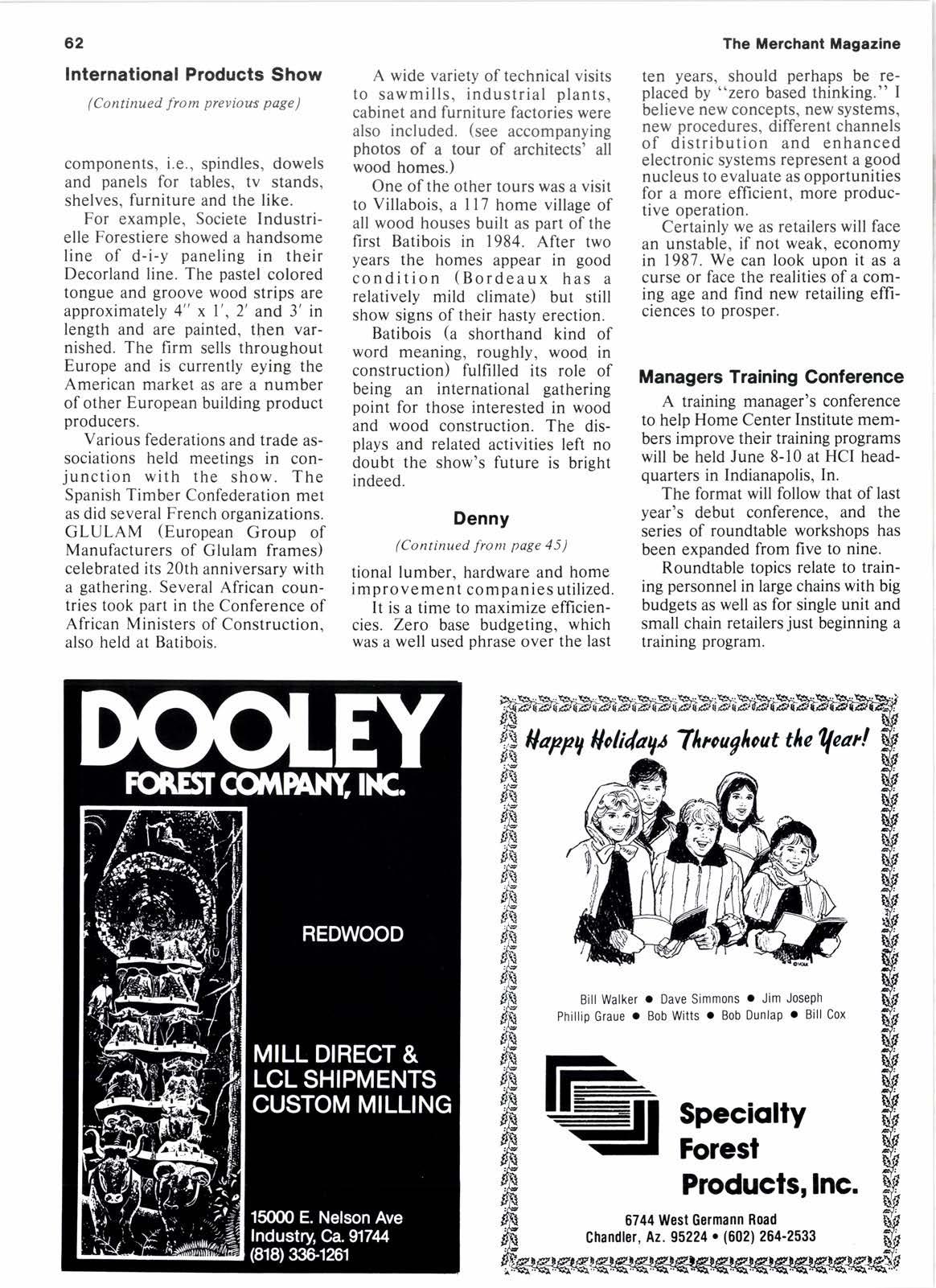
It is a time to maximize efficiencies. Zero base budgeting, which was a well used phrase over the last ten years, should perhaps be replaced by "zero based thinking." I believe new concepts, new systems, new procedures, different channels of distribution and enhanced electronic systems represent a good nucleus to evaluate as opportunities for a more efficient, more productive operation.
Certainly we as retailers will face an unstable, if not weak, economy in 1987. We can look upon it as a curse or face the realities of a coming age and find new retailing efficiences to prosper.
Managers Training Conference
A training manager's conference to help Home Center Institute members improve their training programs will be held June 8-10 at HCI headquarters in Indianapolis, In.
The format will follow that of last year's debut conference, and the series of roundtable workshops has been expanded from five to nine. Roundtable topics relate to training personnel in large chains with big budgets as well as for single unit and small chain retailers just beginning a training program.
Wickes On Acquisition Binge
Wickes Cos., anxious to make acquisitions before the end of the year, has agreed to acquire Collins & Aikman Corp. for $1.16 billion and Lear Siegler Inc. for $1.7 billion.
The acquisition of Lear Siegler is currently in doubt with Wickes having trouble obtaining financing because of the Boesky scandal.
Completion of the acquisitions will allow the company to begin using about $425 million in tax-loss carry-forwards to shelter the income from profitable acquisitions.
Lear Siegler, a Santa Monica, Ca., neighbor of Wickes, is a mili-
Schlaeger
(Continued from page 16) think prices will probably hold firm or even increase slightly. tary and commercial aerospace business as well as a maker of automotive parts and electronics. Collins & Aikman is a New York maker of auto upholstery, fabrics and wall coverings. mluil hmXupfu mcfo frtomfus, t 50fl5tr[[ 5 Sr0firlnfls5 muutu eher€ gmum fufsfg
Canadian producers have enjoyed up to a 33% share of the U.S. market. On Oct. 16 of this year, an import duty of l5o/o was imposed on imports of Canadian softwood lumber. The net effect could mean an increase in demand from U.S. mills in the Pacific Northwest, if they are prudent in their pricing. At any rate, there is little doubt this action will exert an upward pressure in FOB mill prices in softwood lumber domesticallY, as well as a probable increase in transportation prices due to spot shortages of lumber-hauling equipment by western rail carriers.
The two transactions are expected to give Wickes annual sales of more than $8 billion and assets of more than $6.5 billion. Wickes, which emerged from a Chapter ll bankruptcy reorganization in January 1985, alreadY has interests in lumber, home furnishings, apparel, automotive Parts' manufacturing and retailing.
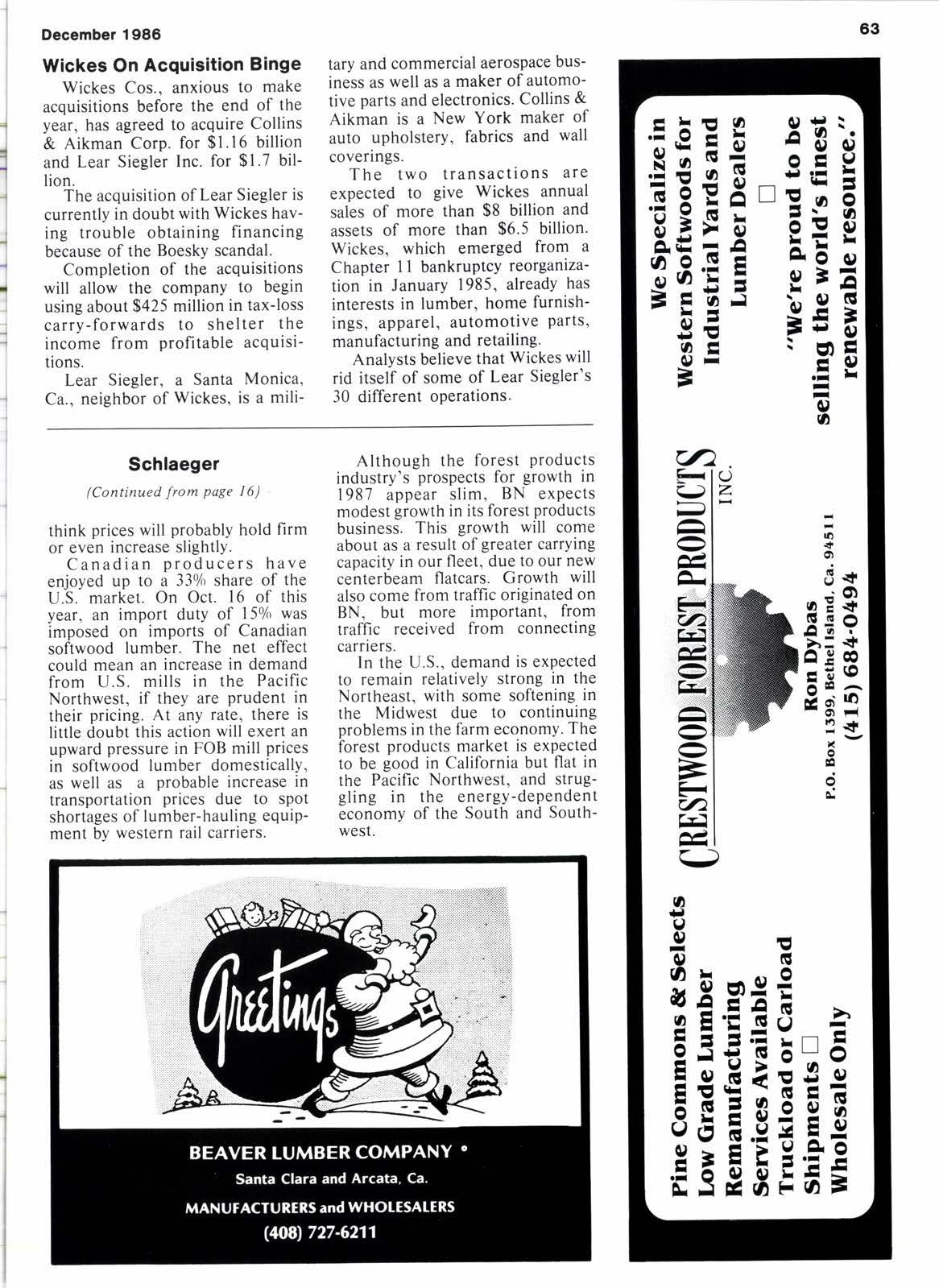
Analysts believe that Wickes will rid itself of some of Lear Siegler's 30 different operations.
Although the forest products industry's prospects for growth in 1987 appear slim, BN exPects modest growth in its forest products business. This growth will come about as a result of greater carrying capacity in our fleet, due to our new centerbeam flatcars. Growth will also come from traffic originated on BN, but more important, from traffic received from connecting carriers.
In the U.S., demand is expected to remain relatively strong in the Northeast, with some softening in the Midwest due to continuing problems in the farm economy. The forest products market is expected to be good in California but flat in the Pacific Northwest, and struggling in the energy-dePendent economy of the South and Southwest.
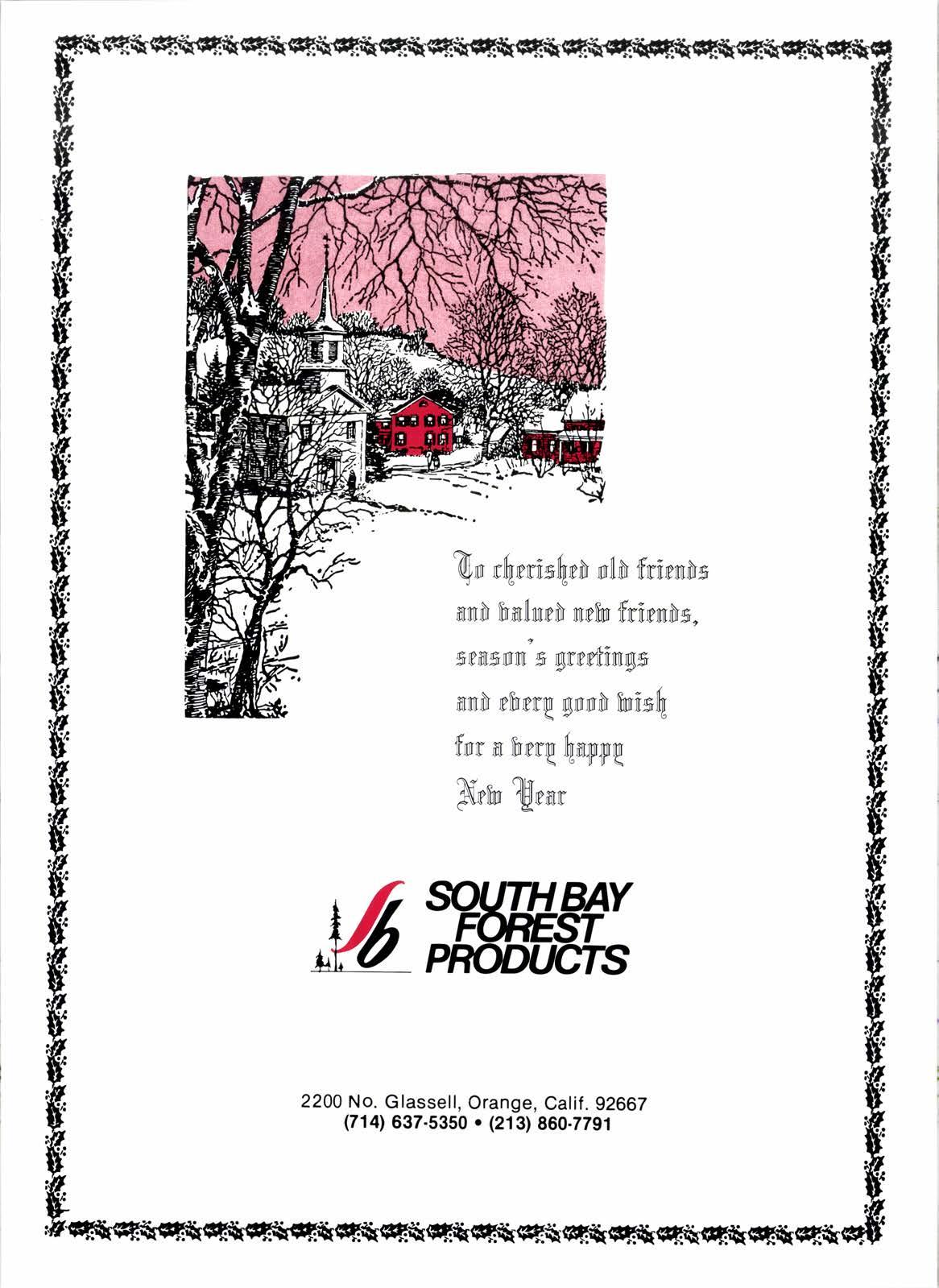
(a{ r0r tr uorq qmfl#u
N'em ?$emr
Quick Quotes For 1987
(Continued from Page 3 8)
"Throughout the business community, you get almost unanimous agreement that the most difficult problems facing us are the deficits of both budget and trade. "
Robert Beck Chairman Prudential Insurance Co.
"When you try to put it all together, the message is that the economy isn't breaking out one way or the other from the slow growth, low-inflation environment that it's been locked into."
Robert Dederick Chief Economist Northern Trust Co.
"The great question is whether and will seek out and exploit the opportunities here and abroad made aligned exchange rates."
Paul A. Volcker Chairman Federal Reserve Board
management can new competitive possible by better
"The economy is likely to grow at an inflationadjusted annual rate of 3.50/o to 40/o next year."
Beryl Sprinkel Chairman Council of Economic Advisers
"Retail sales figures suggest consumer spending is slowing down from its torrid pace earlier in the year, but the figures shouldn't send anybody into a tailspin about a collapse."
Sandra Shaber Economist Chase Econometrics
"Residential real estate will continue to be the bright spot in the state's and the nation's economies."
Joel Singer Economic and Research Department California Association
of Realtors
Annual Clinic & Machinery Show
The l5th annual Clinic and Machinery Show will be held at the Memorial Coliseum, Portland, Or., March 4-6. More than 475 exhibit spaces have already been sold with a limited number still available.
Sponsored by Forest Industries magazine, the event is the industry's largest annual exhibit of sawmill,and panel production technology and equipment. It will include six half-day sessions and three full-day sessions. Cost is $75 for each half-day session and $150 for each full-day session.
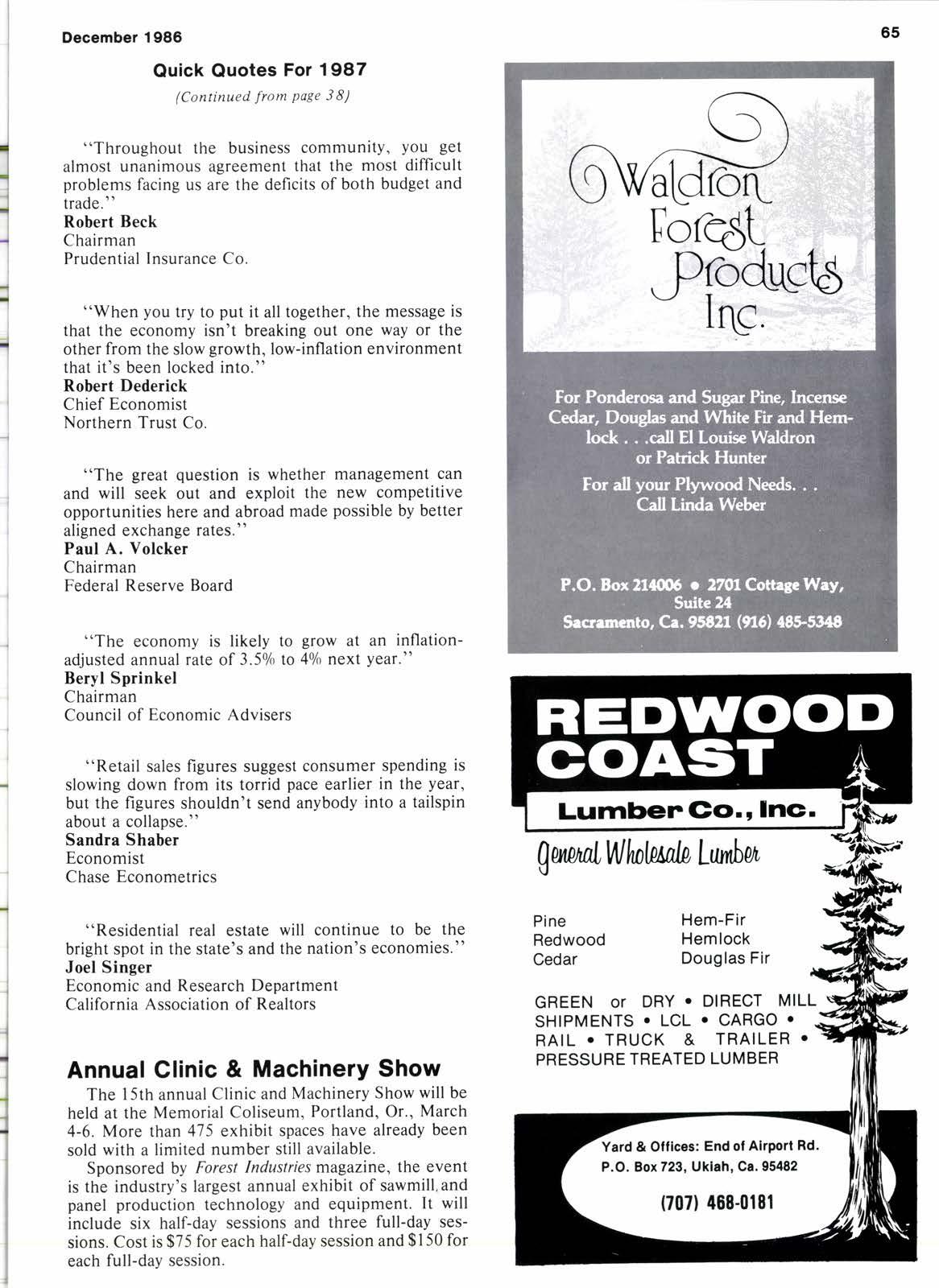
gaillnal W talprrila Lunrbp,t Pine Redwood Cedar
Hem-Fir Hemlock Douglas Fir
GREEN or DRY . DIRECT MILL SHIPMENTS . LCL O CARGO O RAIL . TRUCK & TRAILER ' PRESSURE TREATED LUMBER









